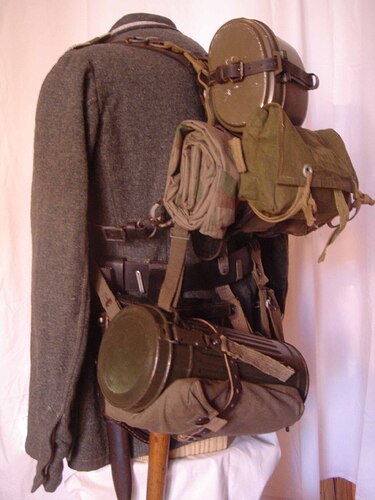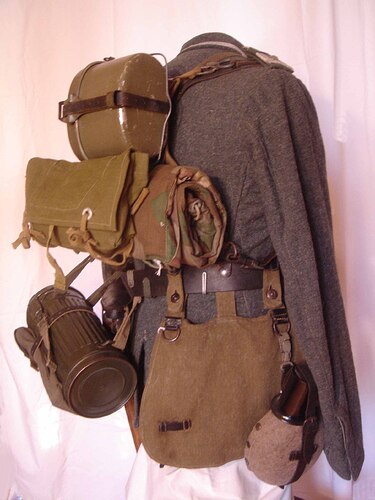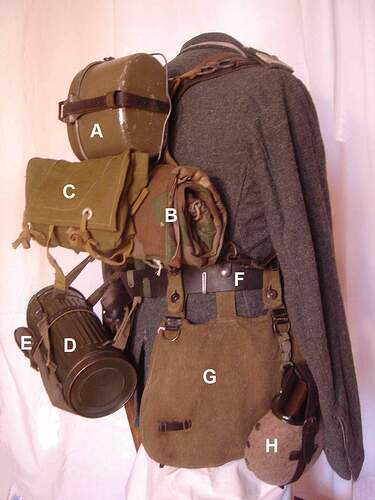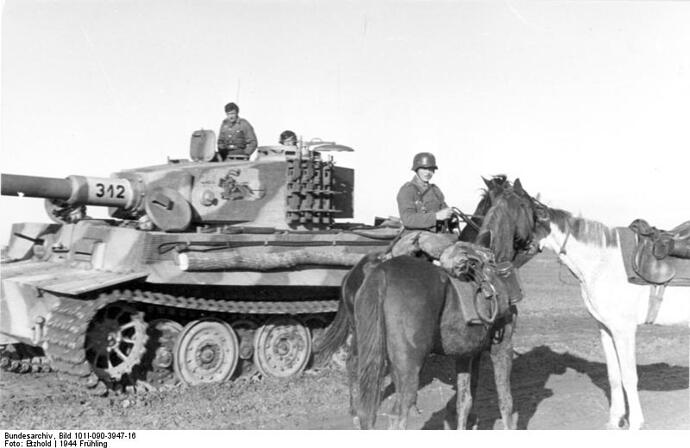Your annotated picture is correct except for “F” which is the normal leather waist belt.
There were, however, a pair of smaller under-arm straps which were part of the combat Y-straps. These are almost never depicted on injection molded model figures.
These smaller straps were riveted under the front straps and were then passed under the arms to attach to equipment items carried on the back (such as the A-frame or one of the other backpacks). You can see the point where one of these smaller straps is hooked to the bottom corner of the A-frame just above the place where you put your letter “F”.
The shiny dot to the left of the letter “F” is the hook from the center strap of the bread bag. Later versions of the bread bag used a simple canvas cloth loop in place of this short strap and hook.
To the left of that hook is an aluminum, bent wire hook that is actually a removable part of the tunic designed to support the leather waist belt. There were (variously depending on the tunic) 2 or 4 of these hooks that were suspended from cotton straps sewn into the twill lining of the tunic. There were matching round “button” holes sewn in the wool of the tunic for the hooks to pass through. (The entire arrangement was also adjustable for height.) (The bent wire suspension hooks were removable to allow the tunic to be washed or when they weren’t needed, for example in garrison, etc.)
So, this equipment is typical for an infantry, Jaeger, or Panzerjaeger (i.e. mech infantry) troop. Panzerjaeger troops had the advantage of their motorized transport (at least in theory) in which they could have stowed much of their personal kit in, thus lightening their fighting loads. Dismounted infantry and Jaegers would have probably “humped” most of this load. Again, with all units, the excess clothing and other personal items would be carried with the unit’s trains.
Tank crews in armored units were also supported by that unit’s own baggage trains. Generally speaking, though, German armored units were (in theory) completely motorized, so their trains would have been truck and trailer born. However, as the war progressed, the substitution of some horse drawn transportation for armored and mech units cannot be discounted. This would have been on a case-by-case basis, though, and as far as I know there were no official changes in the tables of organization and equipment to make such substitutions.
Tank crews would not be issued the A-frame (Traggestelle or “carrying gear”). That was an infantry-only issued item. They would have been issued the mess kit, water bottle with cup, Zeltbahn and gas mask. There were often designated and designed stowage locations inside many German AFV’s just for these items. They were also issued the same clothing bags to carry excess uniform items in their unit’s baggage train. However, consider that it would have been quite easy for a tanker, for example, to simply stuff his great coat into some convenient nook or cranny to have it available or even to provide a bit of extra padding and a more comfortable ride.
Regular infantry divisions, on the other hand, were very much horse-born, so horse drawn baggage trains would have been common. The same applies to many other types of organizations, such as artillery batteries supporting regular infantry divisions and corps composed of mostly regular infantry divisions.
Something that should be understood is that a unit’s baggage train is also pretty much synonymous with its organic supply / resupply capability. So, when thinking about baggage trains, imagine an area near the company’s higher battalion (Abteilung) service and supply facilities where the company’s personal baggage trailers have been parked while the towing vehicles are being used to move supplies from the brigade or division supply dumps down to the battalions and then on to the forward positioned companies. Companies and platoons that have been rotated out of the front line would be billeted in and around this same general geographic location where they would be able to wash, rest and repair and maintain their own clothing, equipment and weapons.
Baggage trains were not something that were located so far away from the company that they were inaccessible to the individual soldiers. It would have also been possible for a soldier to use his chain of command to request that some particular item or items be brought forward from the trains. Alternatively, a soldier could be sent individually back to the company supply area on a working detail, say, and then also have access to his personal baggage.
Likely, the longer a unit was stationary, the more likely it would have been that more and more personal “comfort” items would accumulate around the individual fighting position. The longer a campaign went on, the more likely it would have been for mechanized troops (to include tankers) to collect and accumulate personal items in and on their vehicle, which served as both their home and primary weapon.
Moving on to your final questions, assault gun and tank hunter units would generally follow the same patterns of personal baggage management as other mechanized or armored units. It should be noted, though, that independent StuG battalions (Abteilung) were corps support units that were task organized and attached to divisions, so they had a pretty robust self-support and transportation capability. (This is an interesting historical study in and of itself.)
Finally, vehicle tarps could be camouflage pattern painted. It’s fairly common to see tarps on vehicles where the camouflage paint on the vehicle was carried onto the tarps (either partially or fully). Prewar tarps were pattern painted according to the regulations applicable. Those early tarps continued in service until consumed by the war. Larger German army prewar tentage was manufactured using camouflage patterned material (sort of like ginormous Zeltbahn patterns). Again, these were used until consumed by the war.
German camouflage uniforms, Zelts and tentage is an entire field of study in its own right.




